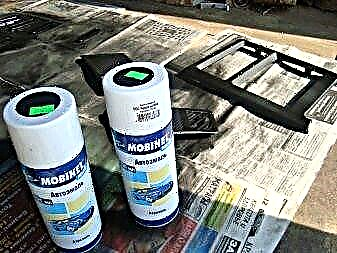 Concrete flooring without proper treatment emits too much dust, causing a lot of trouble to its owners. Therefore, it is recommended to grind and polish such a surface in order to operate as a clean coating. It is also necessary to grind the floor before processing with dust removal impregnations, painting with paints and varnishes.
Concrete flooring without proper treatment emits too much dust, causing a lot of trouble to its owners. Therefore, it is recommended to grind and polish such a surface in order to operate as a clean coating. It is also necessary to grind the floor before processing with dust removal impregnations, painting with paints and varnishes.
Grinding methods
There are two methods to make a concrete surface smooth, denser and more durable with grinding equipment:
- The wet method using water is usually used to process mosaic floors (made of concrete mix with marble chips). The result is an absolutely polished surface that requires virtually no finishing. Excess water and sludge are removed by a suction pump.
- The dry method is used for grinding ordinary concrete. The disadvantage of this method is a large amount of dust during operation. Therefore, simultaneously with the use of grinding machines, a vacuum cleaner must be used. Advantage - errors and omissions are immediately visible. Whereas during wet processing it is necessary to dry the object in order to detect defects.
How to grind concrete
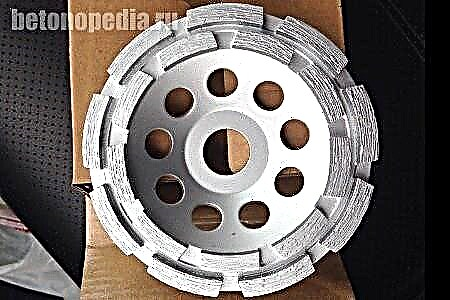 For large areas it is better to use professional equipment. Special grinders are equipped with devices for controlling the rotation speed of moving parts and water supply, dust and sludge collectors. Most models are endowed with planetary mechanisms of action. This is a large-diameter disk on which working nozzles with diamond tips are fixed. They can move in one or opposite directions to achieve a better result.
For large areas it is better to use professional equipment. Special grinders are equipped with devices for controlling the rotation speed of moving parts and water supply, dust and sludge collectors. Most models are endowed with planetary mechanisms of action. This is a large-diameter disk on which working nozzles with diamond tips are fixed. They can move in one or opposite directions to achieve a better result.
But if you need to polish the floor in the garage, then it makes no sense to purchase such equipment. You can do with tools from home storage.
Grinding procedure
Any finishing work requires careful preparation of the surface, the process of grinding the floor is no exception.
- If the floor is re-flooded, then it is necessary to check its evenness with a long ruler, level, level. When working with an old coating, you should get rid of the remnants of the previous finish. We remove garbage, dust, dirt, remove the protruding metal mesh or fittings, if any are found.
- In the presence of deep potholes, cracks or large deformations of shrink joints, you will first have to work with them. We close them with a solution of increased strength, preferably with the use of cement, to ensure a high filling density. For sealing, you can also use epoxy mastic. Filling of defective places should be done flush with the main surface.
- If concrete knolls, sagging are detected on the field, they must also be removed before the final grinding is started. We work with a grinder with a diamond disk at number 30-40, indicating the granularity of the working area.
- The first layer of cement milk is removed from the new screed first. By grinding the existing floor, damaged areas are removed, and small deformations and shallow spots are eliminated.
Do-it-yourself sanding can be started no earlier than 14 days after the concrete is completely dried or the cement screed. If you do not wait this period of time and work with a damp surface, then the grinder can simply tear pieces of rubble out of the concrete mass.
The nuances of work
For grinding a concrete coating with an angle grinder, not ordinary circles are used, but so-called diamond bowls of various designs. Moreover:
- Before grinding, the floor is treated with special reinforcing compounds. These substances, entering into a chemical reaction with calcium derivatives in the composition of concrete, create a strong film that closes the pores of the coating and gives the material high resistance to moisture penetration.
- Processing of a concrete floor with a grinder with diamond bowls is carried out in stages, starting from the corner of the site, gradually moving around the room.
- When grinding, it is necessary to check the evenness of the process by a level or a large ruler.
Using bowls with different grain sizes can achieve exceptional smoothness. This may be the final stage of work. But to achieve greater gloss, the floors are polished with the same UGM with special nozzles. To preserve polishing for a long period of time, the concrete is cleaned of dust and painted with several layers of polyurethane varnish with any paint tool. It is important when varnishing or painting each coat to dry before applying the next.
Why grind concrete?
Correctly carried out grinding of concrete even without applying a protective layer improves its characteristics:
- Simplified concrete floor maintenance
- Longer service life
- The concrete surface fits well in most interiors of commercial or public buildings,
- Not afraid of aggressive influences, so it can be used on the street,
- It has high mechanical strength, which prevents the formation of cracks and seams.
This is due to the fact that the features of the polished concrete floor are water resistance, resistance to chemicals, the top layer is hardened.
This procedure, as a rule, is carried out on horizontal concrete surfaces in order to improve their quality by removing the less durable top layer. On freshly poured mass, lime milk accumulates, reducing its strength. On the third or fifth day, the first stage of work is done, and the full cycle ends after the solution has solidified. The concrete surface polished with special equipment becomes exceptionally smooth, but with a high level of adhesion, which is important for applying and firmly holding protective coatings.
Old concrete screeds or structures always damage the top layer, as it absorbs moisture, has microcracks and other minor defects. When grinding it, the task is to completely remove this one, to remove dirt, chips and surface cracks. Before sanding an old concrete floor, you need to make sure that it does not have wave swings and has a horizontal direction, such problems are corrected only when pouring a new screed.
Methods and types
There are two main technologies for grinding a concrete floor or another structure - the wet and dry method. Characteristically, this uses the same equipment, the abrasive disc of which must cope with solid material.
Wet sanding the floor is more suitable for surfaces covered with mosaics or marble chips. Abrasive segments are used, with the possibility of fine processing, providing perfect quality similar to the result of polishing. In the process, a layer of wet sludge is formed, which interferes with correctly assessing the degree of processing, which requires high professionalism from the master. To pump out excess water, a spillway is used.
The dry sanding of concrete floors is more suitable for this material, although it requires more time. Dust is formed during processing, but it does not interfere with quality control. A special vacuum cleaner is provided for its removal. Another advantage of this method of work is low cost due to simple equipment. In small areas and in inaccessible places, grinding of concrete can be done with a grinder.
Targets and goals
It should be noted that the final result of processing a concrete surface directly depends on the quality of the grinding performed. The latter involves the removal of the upper layer of the screed, which is not able to "boast" of optimal strength and decorative attractiveness. If we single out the tasks for which grinding is used, then their list is as follows:
- elimination of a weak top layer when arranging a new concrete floor, providing for getting rid of various surface defects,
- preparation for finishing polishing or applying decorative coatings that need to create the most even base,
- the creation of roughness, which allows to increase the adhesion force of the concrete surface with the bulk floor,
- restoration of the lost characteristics of the old base, which involves the removal of the worn outer layer,
- ensuring the best operating conditions, achieved by getting rid of the upper part of the concrete surface - a source of harmful dusty suspension.
It is also worth adding that the implementation of grinding allows you to get a surface that can "boast" of the following obvious advantages:
- reliability due to which the concrete floor can withstand severe loads - both static and dynamic,
- high maintainability, not implying significant financial costs,
- resistance to formulations whose components are fats or aggressive chemical compounds,
- compliance with applicable environmental safety standards,
- the ability to organically fit into almost any modern interior.
As for concrete surfaces that are not polished, all of them lose their main quality - strength. This is primarily due to the fact that defective areas of the untreated floor are subject to crumbling. In addition, such surfaces strongly absorb moisture, which is especially noticeable in open spaces, as well as in apartments and other rooms located on the ground floors.

How to polish?
One of the best solutions that can cope with this task is considered to be a "helicopter". It is a high-performance grinding machine, the processing elements of which are arranged in the form of blades.
Another common option, the use of which allows you to level the concrete floor, is a grinder - an angle grinder equipped with diamond cups or abrasive disks. It also allows you to achieve the desired result, but still the rental of professional tools significantly accelerates the implementation of the planned procedures.


Practice shows that specialized grinders have a number of notable advantages. In particular, they have the following useful features:
- the ability to change the speed of work items,
- dosed water supply when performing wet processing of a concrete surface,
- collection of waste generated during grinding.
Professionals note that the quality of the procedure carried out is determined by the mass of equipment used: the more the latter, the better the final result. The only drawback of powerful machines is the high cost of rent, because of which it is reasonable to polish floors with their use only in large areas.
If we list the main advantages of the grinders, then first of all, their cost-effectiveness and the possibility of high-quality processing of hard-to-reach areas should be included. The optimal solution for leveling the surface of a concrete floor is an average grinder, the disc of which has a diameter of 150 to 180 mm. Using such a power tool is not particularly difficult, and the main condition, compliance with which allows you to achieve the desired result, is accuracy. Ignoring this recommendation can lead to damage to the work surface, and sometimes to injuries of varying severity.
Another tool you might need to clean up a concrete floor is a polisher. It is needed in situations where the owners of the premises do not plan to lay the decorative coating on a polished surface. This unit is very ergonomic, and the efficiency of its operation allows you to get a polished concrete floor with the least time.

Ways
Grinding is a procedure that can be performed on any concrete surface. As for the time that is best suited for its implementation, experts consider the period as such 15-20 days after pouring the screed. The reason for this is quite prosaic: sanding before the specified time can lead to tearing gravel out of the coating, which did not have time to find the proper hardness.
Training
Before sanding the concrete floor, the owner of the room The following significant points should be taken into account:
- If there is any coating on the old concrete base, it is necessary to assess the degree of difficulty in removing it. In addition, in such cases, latent floor damage can be detected - a problem that often requires serious time and effort to solve.
- Prior to the abrasive treatment of the concrete surface, it should be checked for evenness. In a situation where the base suffers from significant elevation changes, the grinding intensity must be increased.
- Subject to the presence of expansion joints and cracks, they must be carefully repaired.


- In order to determine the degree of strength of the floor, before grinding it needs to be tapped.
- Given that the treatment of concrete surfaces involves the use of power tools, it is worth checking the parameters of the network used. If the obtained values do not correspond to the declared ones, measures should be taken to stabilize the energy supply.
- In a situation where there are gaps between the baseboard and the floor, you must get rid of them. This condition is mandatory, which is confirmed by applicable building codes.
Another action, the implementation of which allows you to get a clear idea of the specifics of the treated floor, is to check the surface material for rigidity. It is carried out by means of a grinding machine, which must be carried out on any part of the concrete floor.
If reinforcement is present in the latter, then it must be removed in advance so as not to damage the tool used. This problem can be solved with the help of the previously mentioned grinder.
Technology
To date, two varieties of grinding of concrete surfaces are known - wet and dry. Each of them has its own remarkable features:
- Wet sanding. As a rule, the described technique is relevant for enclosed spaces. In most cases, concrete floors are treated in this way, which includes marble chips - aggregate, which makes the surface more beautiful and reliable. The grinding method under consideration involves the use of water that has a softening function, reduces the amount of dust formed and reduces the heating of abrasive elements. It is worth adding that wet sanding is possible only in heated rooms equipped with efficient drainage systems.
- Dry grinding. Experience shows that the presented method is significantly more popular than the previous one. Moreover, this processing method is time-consuming, due to significant volumes of rising dust. Until it settles, grinding is not recommended in order to minimize the likelihood of errors. The only thing that can help in this situation is the use of construction vacuum cleaners that can “boast” of maximum performance.

To begin with, rough grinding should be carried out using circles or nozzles with a grain size of 25-30 grit.Performing this procedure allows you to get rid of small tubercles, so that the concrete surface becomes visually smooth.
If the coating is too problematic, then you can speed up its processing through sandblasting machines and milling tools.
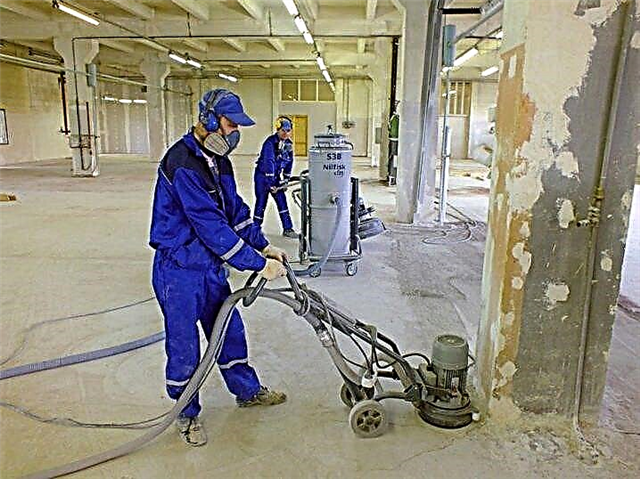
The next step is grinding the floor with the use of nozzles and circles, the granularity of which is in the range of 40-100 grit. This procedure involves removing a significant layer, so that the concrete surface gains maximum strength. This problem can be solved both with hand tools (for example, an angle grinder at home), and with more productive devices - up to industrial-class installations, if their use is justified.
Special attention should be paid to grinding using a grinder, the abrasive element of which has a grain size of 400 grit or more. The logical result of the use of such a tool is a concrete floor with optimal wear resistance. Experts say that such surfaces are undemanding and do not need facial coatings.
Upon completion of grinding the concrete base, it must be impregnated with a sealing agent - a composition that significantly increases the surface's resistance to strong mechanical stresses. As for situations where the floor needs to be given maximum smoothness, they suggest the use of abrasive elements with grit from 300 to 1500 grit, and in some cases up to 3000 grit.
The number of steps to properly polish a concrete surface is determined by the decorative requirements for it.


Professional Tips
Talking about the features of such a procedure as grinding a concrete floor, it makes sense to list several recommendations, each of which is interesting in its own way:
- The best materials are processed, which include marble chips, and worst of all, mixtures with sedimentary gravel and granite. It is also important to consider that aggregates with too high a density complicate the grinding procedure, and with a lower density, they noticeably worsen the quality of the coating to be equipped.
- If the floor will be used at an industrial facility, its top layer is reasonably treated with topping - a mixture that makes the surface more durable. The main component of such compositions is cement, combined with quartz, basalt, corundum materials, metal particles and other aggregates.
In order for the concrete surface to be equipped to last as long as possible without repair, experts do not recommend saving on impregnation. These compounds should be applied to concrete until it no longer absorbs them.
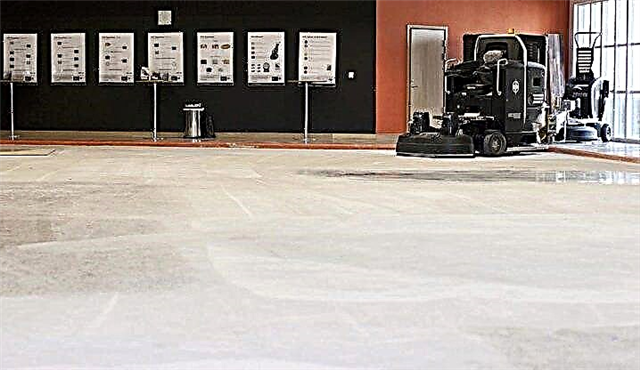
Finally, it remains to state that grinding the floor is an excellent solution to problems requiring the elimination of not too strong irregularities in the concrete surface. It is quite possible to carry out such a procedure with your own hands, not forgetting the recommendations mentioned in this material. Provided that everything was done correctly, the owner of the premises will receive a beautiful and durable floor, fully justifying the forces, time and financial resources spent on it.
You will learn more about how to grind concrete floors from the next video.
The main advantages of polished concrete floors

Grinding a concrete base with a grinder provides the following advantages:
- increased surface strength, resistance to mechanical stress,
- reduction of further costs of maintenance, care and restoration of the upper layer of concrete floor,
- a significant improvement in appearance, increasing the aesthetics and attractiveness of the concrete surface,
- expanding the scope of application, including the use of bases in conditions of exposure to high humidity, severe frosts, other adverse climatic and other factors,
- use in conditions of constant high loads from machines and mechanisms, in places of increased passability of people, etc.
Are there any flaws in this work. Except for the relatively high cost of work, then there are no other minuses. And if you use a hand tool, organize and carry out the grinding of a concrete floor yourself, with your own hands, in accordance with the technology for processing similar surfaces, you can save money here.
Application area
The most widespread polished concrete floors were in the following buildings and structures:
- administrative buildings,
- industrial premises,
- warehouse complexes and hangars,
- shopping centers and supermarkets,
- athletic facilities,
- cultural centers
- Hotels and restaurants
- some objects in private housing construction (garage sites, car parking, etc.).
The optimum time for sanding concrete floors
The most common technology, which is used in the process of processing a concrete floor by grinding, determines the optimal time to complete the work. This is an interval of 10-15 days after pouring the concrete surface. It has been proven that during this time concrete will gain the necessary strength, and the filler elements — crushed stone, granite, gravel or marble chips — that are included in it, will “grasp” the base quite firmly and remain in place during floor polishing and will not break out of the screed .
The main types of work
Grinding concrete, which is carried out, including, and with your own hands, can be performed in one of two ways: dry and wet. For different options for processing a concrete base, the same equipment, tools and devices are used. The difference in the technology used, as well as in the cost of work.
It is advisable to apply the wet method of processing a concrete floor on mosaic surfaces, in those places where it is necessary to process a surface with marble chips. Typically, these floors are made in places of active movement of people. Production, warehouse, etc. concrete screeds are recommended to be treated with the dry method, and industrial vacuum cleaners are used to remove the dust that forms abundantly during grinding of the floor.
Basic equipment and tools

To polish the floor, professional grinders, as well as various hand-held power tools, are currently used. Of course, the use of powerful specialized equipment allows you to get a better result. The grinding of concrete here is carried out using special diamond nozzles, which are fixed on the surface of the grinding disk with auxiliary wheels.
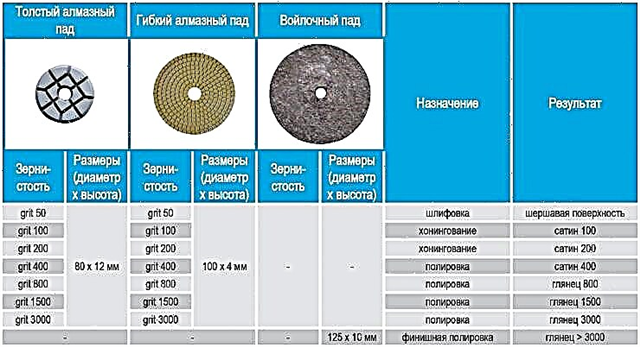 Diamond blades rotate at high speeds in opposite directions and grind the surface of the concrete floor perfectly smoothly and smoothly. Professional-made grinders are controlled by an operator who has the ability to control the speed of rotation of the disc, as well as to supply water, to collect dust during dry and sludge - when wet polishing the floor. Structurally, such a machine consists of the following components:
Diamond blades rotate at high speeds in opposite directions and grind the surface of the concrete floor perfectly smoothly and smoothly. Professional-made grinders are controlled by an operator who has the ability to control the speed of rotation of the disc, as well as to supply water, to collect dust during dry and sludge - when wet polishing the floor. Structurally, such a machine consists of the following components:
- metal case
- electric motor
- control equipment
- switch (bag),
- surface grout disc,
- wheels to move the unit,
- lever for controlling the process.
When using a home tool - a grinder, in addition to a diamond disk, other types of nozzles can be used, for example - round wire or twisted wire.
Pricing
The total cost of the work is determined by the type of measures taken, which, depending on the tools and materials used, as well as the applied method of processing the concrete floor, include:
- rough grinding of concrete,
- diamond grinding,
- polishing the surface of the concrete floor,
- processing of concrete screed of high grades of cement,
- paint removal,
- grinding steps, risers, landings,
- use of a vacuum cleaner.
Prices for all types of specified works are calculated taking into account a square meter, and at the preliminary stage they are agreed with all interested parties.
Organization of concrete grinding
 All concrete floor processing activities consist of three parts:
All concrete floor processing activities consist of three parts:
- preparatory
- main,
- final.
At the preparatory stage, it is necessary to remove (if any) the paintwork, and also check the level of the surface plane. If the floor is uneven, then the first step is to use a diamond disk with a large number of diamonds.
The next stage is the removal of all defects visible and opened after preliminary work. Using special mastic on an epoxy basis, seams, cracks and potholes are processed.
Directly grinding the concrete floor itself is the main stage, it is carried out in several stages, including rough, fine, finishing grinding of concrete, as well as processing with special compounds and polishing.
At the final stage, the surface is thoroughly cleaned of dust, fine crumbs, and other objects. Survey of the surface and delivery of the object to the customer.
Sound conclusions
The works on conducting the surfaces of concrete floors in order, performed in accordance with the developed technology, can significantly improve the quality, extend the service life and give the surface an attractive appearance. In order to ensure high quality and affordable prices, it is necessary to correctly assess the volumes, determine the tasks and choose the right way to do the job. If you are confident in your capabilities - you can try to do the job yourself.
Types of concrete grinding
The polished concrete surface treated with polyurethane varnish is similar in appearance to a self-leveling floor and polished stone. At the same time, concrete is more resistant to damage and easier to repair. The treated surface is not dusty, not afraid of moisture and aggressive environments - such floors can be equipped inside a residential building.
There are two technologies for processing concrete: wet and dry grinding. For work the same tools and expendables are used.
Wet grinding
Suitable for high strength concrete with granite filling. This method requires more consumables, and therefore more expensive. Wet sanding removes the top layer of concrete up to 5 mm thick.

Using a hand tool is difficult, since it is necessary to remove water from the work surface using a special drainer. Wet dirt covers the treated floor, and grinding errors can only be seen after it has been removed or dried.
Dry grinding
During dry processing, a layer of concrete up to 2 mm thick is removed. This creates a large amount of dust and requires the use of protective equipment for the organs of vision and breathing.

Dry sanding concrete requires less time and labor than wet sanding. Dust settles quickly, so you can immediately evaluate the quality of processing and correct errors.
Grout fresh screed
This technology is used to create strong, wear-resistant floors in industrial and commercial premises, hard coatings in open areas.
The helicopter for grinding concrete is a manual or self-propelled trowel with a diesel, gasoline or electric engine. With its help, the screed is processed 4-20 hours after installation. This allows the top layer to be compacted; cement-based toppings are used to enhance the effect.

After rough grinding for 10-16 hours, the finish is performed. In this case, dust-free impregnation is rubbed into the surface of the concrete. Processing with a fresh screed helicopter makes the floor surface smooth, resistant to cracking. For the decorative effect, pigments are used as part of the topping.
Concrete grinding tools
For the treatment of concrete surfaces are used:
- industrial grinders (convenient for large surface areas),
- household grinders (suitable for use at home),
- angle grinders (grinder can be used to polish the floor in small rooms and inaccessible places).

The most affordable grinder for home use. It is most convenient to work with a tool with a large weight and two handles. For grinding concrete without dust, you should choose a model with a casing to which the hose of an industrial vacuum cleaner is connected.
Consumables for angle grinders
There are several types of nozzles for grinding concrete:
- Cups. They are disks with a recessed center. Purpose depends on the shape of the work surface:
- with square overlays - for roughing with cutting protruding concrete fragments,
- with a double segment - for uniform removal of the top layer,
- with boomerang overlays - for surface polishing.

- Disks (circles). Have a flat surface with an abrasive applied to it:
- with large and medium-sized diamond chips - for rough grinding,
- with small crumbs and cellular structure (turtles) - for polishing.

- Frankfurt. Special trapezoidal nozzles. Depending on the type and characteristics of the working surface, they are used for grinding or polishing concrete floors.
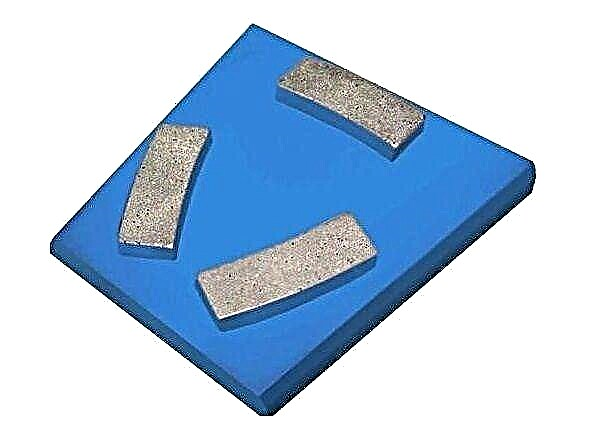
Work stages
Regardless of the selected grinding technology, it is first necessary to prepare the surface. For this:
- remove the old coating (if any),
- protruding fittings are removed
- drill holes if they are provided by the project (drilling after grinding will spoil the appearance of the finished floor),
- close the potholes and cut the grooves revealed when checking the flatness of the surface using a three-dimensional ruler,
- the stiffness of a fresh screed is checked - grinding work can be done only after curing, otherwise the nozzle on the grinder will tear pieces of concrete, clinging to the filler.
Grinding process
For diamond grinding of concrete, abrasive wheels with a cat of different fractions are successively used: 25-30 units at the initial stage and 40 for finishing grinding. Polishing to give a gloss surface is carried out using disks with abrasive chips of 1500-3000 units.
- The prepared surface is impregnated with a special hardening solution.
- The floor in several runs with a decrease in the size of the abrasive particles is ground to smoothness using a dry or wet method. In the second case, before treatment it is abundantly watered with water.
Before using a household or industrial grinder (you can rent them), you should study the instructions in detail. In hard-to-reach places, the floor is treated using angle grinders.
If the entire surface is grinded with a grinder, it is necessary to take breaks every 10-15 minutes to avoid breaking the tool from overheating.
At the final stage, the sanded floor is cleaned of dirt and dried. Then it is coated with paint on concrete or polyurethane varnish in 2-3 layers with intermediate drying.
Conclusion
Grinding concrete allows you to create a high-quality coating, designed for decades of operation under high loads. At home, you can cope with the work on your own using a household tool. It is important to choose the right nozzles taking into account the strength characteristics of concrete and the filler fraction.
Tool
The selection of tools and equipment for grinding floor screed or other areas is selected based on the volume and characteristics of the object.In professional grinding machines, the principle of the planetary rotation mechanism of one large and several smaller disks with diamond abrasives is implemented. They rotate in opposite directions, carefully treating the surface. Such equipment has a number of advantages:
- Adjustment of rotation speed of abrasive disks for processing various grades of concrete,
- Wet grinding water supply,
- Built-in vacuum cleaner and dust collector for dry processing.
For small areas or in domestic conditions, everything is done by a grinder with a nozzle for grinding concrete. This allows you to reduce the cost of work and improve their quality due to the ability to carefully process corners and other hard to reach places. On grinders, 2 types of nozzles are used - abrasive discs of different grain sizes and diamond bowls.
How to grind concrete?
At large facilities, work is carried out using industrial equipment, at home you can grind concrete with your own hands using a regular grinder. Regardless of the selected brand of mortar, taking into account further grinding, it is better to choose crushed stone of the minimum fraction, marble chips are well processed. To get the maximum effect, the processes are divided into several main stages.
Performance of work
Sanding should be started after preparation of the old or hardening of the new screed so that the crushed stone does not break out of the concrete structure. The right abrasive discs are selected to ensure high quality machining. Standardly used are diamond disks with a grain size of 40. To improve the quality, a hardener is applied, penetrating microcracks and pores of concrete.
It is necessary to strictly observe safety precautions, since a disk that has crashed and crashed from the mount can cause serious injury.
If defects are detected, they are thoroughly cleaned and sealed with mortars. The presence of a large number of chips, pits, cracks will require the application of a special repair composition of cement and pure quartz sand in several layers so that cracks do not appear.
To obtain a perfectly machined surface, 400 grit disks are used. After such grinding, additional processing is not required, it becomes perfectly smooth and durable. Polishing is carried out with materials with grit sizes up to 3000. To harden the top layer and give it shine, they are treated with special varnishes or polymer compositions.
DIY sanding
To grind a concrete floor with your own hands, a grinder is most often used, since professional equipment is expensive. The choice of abrasive is the same as for heavy grinders. When working with a grinder at home, certain rules must be followed:
- Before starting, the strength of the mounted disk is checked,
- The area to be sanded and polished must be well lit.
- Avoiding overheating of even the best tool, you need to take breaks after every 15 minutes of work,
- It is necessary to use overalls, to close eyes with protective glasses.
Proper sanding will help to quickly, simply and cheaply improve the quality of the concrete surface. In a small area, this can be done independently without investing in repairs for many years. Coating with special compounds gives it an exceptional appearance.


